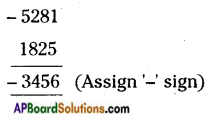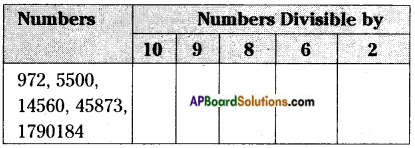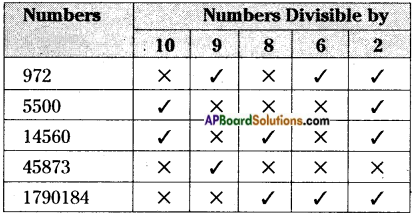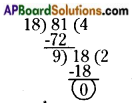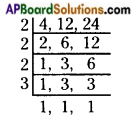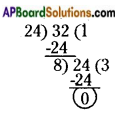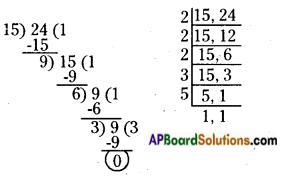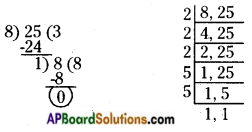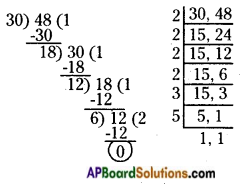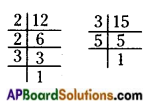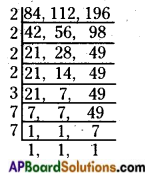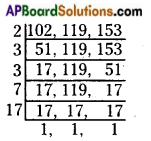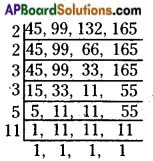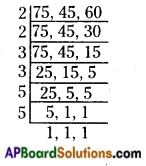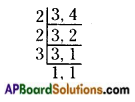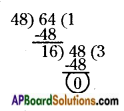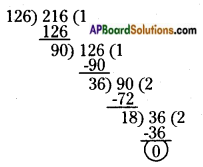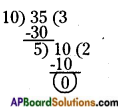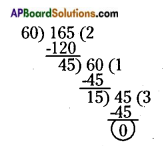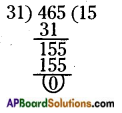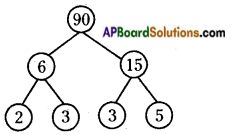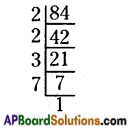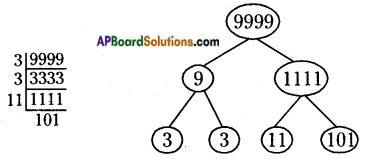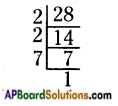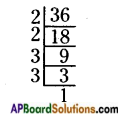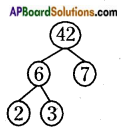AP State Syllabus AP Board 6th Class Maths Solutions Chapter 5 Fractions and Decimals Ex 5.2 Textbook Questions and Answers.
AP State Syllabus 6th Class Maths Solutions 5th Lesson Fractions and Decimals Ex 5.2
Question 1.
Find the product of the following.
i) 3 × \(\frac{5}{12}\)
ii) \(\frac{15}{8}\) × 12
iii) 1\(\frac{3}{4}\) × \(\frac{12}{21}\)
iv) \(\frac{4}{5}\) × \(\frac{12}{7}\)
Answer:

![]()
Question 2.
Which is greater?
i) \(\frac{1}{2}\) of \(\frac{6}{7}\) or \(\frac{2}{3}\) of \(\frac{3}{7}\)
ii) \(\frac{2}{7}\) of \(\frac{3}{4}\) or \(\frac{3}{5}\) of \(\frac{5}{8}\)
Answer:
i) \(\frac{1}{2}\) of \(\frac{6}{7}\) or \(\frac{2}{3}\) of \(\frac{3}{7}\)
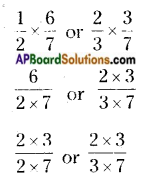
\(\frac{3}{7}\) or \(\frac{2}{7}\)
So, \(\frac{3}{7}\) > \(\frac{2}{7}\)
∴ \(\frac{1}{2}\) of \(\frac{6}{7}\) > \(\frac{2}{3}\) of \(\frac{3}{7}\)
ii) \(\frac{2}{7}\) of \(\frac{3}{4}\) or \(\frac{3}{5}\) of \(\frac{5}{8}\)
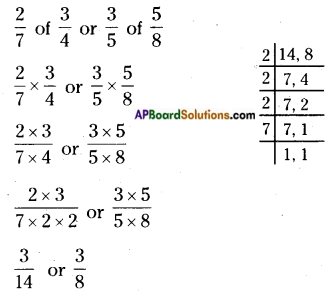
Convert them into like fractions
LCM of denominators = 2 × 2 × 2 × 7 = 56
\(\frac{3 \times 4}{14 \times 4}\) or \(\frac{3 \times 7}{8 \times 7}\)
\(\frac{12}{56}\) or \(\frac{21}{56}\)
So, \(\frac{12}{56}\) < \(\frac{21}{56}\)
∴ \(\frac{2}{7}\) of \(\frac{3}{4}\) < \(\frac{3}{5}\) of \(\frac{5}{8}\)
![]()
Question 3.
Find:
i) \(\frac{7}{11}\) of 330
ii) \(\frac{5}{9}\) of 108
iii) \(\frac{2}{7}\) of 16
iv) \(\frac{1}{7}\) of \(\frac{3}{10}\)
Answer:
i) \(\frac{7}{11}\) of 330
= \(\frac{7}{11}\) × 330
= \(\frac{7}{11}\) × 11 × 30
= 7 × 30 = 210
ii) \(\frac{5}{9}\) of 108
= \(\frac{5}{9}\) × 108
= \(\frac{5}{9}\) × 9 × 12
= 5 × 12 = 60
iii) \(\frac{2}{7}\) of 16
= \(\frac{2}{7}\) × 16
= \(\frac{2×16}{7}\)
= \(\frac{32}{7}\) or 4\(\frac{4}{7}\)
iv) \(\frac{1}{7}\) of \(\frac{3}{10}\)
= \(\frac{1}{7}\) × \(\frac{3}{10}\)
= \(\frac{1 \times 3}{7 \times 10}\)
= \(\frac{3}{70}\)
Question 4.
If the cost of a notebook is Rs. 10\(\frac{3}{4}\). Then, find the cost of 36 books.
Answer:
Cost of each notebook = Rs. 10\(\frac{3}{4}\) (or) \(\frac{43}{4}\)
Cost of 36 notebooks = 36 × 10\(\frac{3}{4}\) = 36 × \(\frac{43}{4}\) = \(\frac{9 \times 4 \times 43}{4}\) = 9 × 43
Cost of 36 notebooks = Rs. 387
![]()
Question 5.
A motor bike runs 52\(\frac{1}{2}\) km using 1 litre of petrol. How much distance will it cover for 2\(\frac{3}{4}\) litres of petrol ?
Answer:
Distance covered by the motor bike 1 litre petrol = 52\(\frac{1}{2}\) km (or) \(\frac{105}{2}\) km
Distance covered by the motor bike for 2\(\frac{3}{4}\) litres of petrol = 2\(\frac{3}{4}\) of 52\(\frac{1}{2}\)
= \(\frac{11}{4}\) × \(\frac{105}{2}\)
= \(\frac{11 \times 105}{4 \times 2}\)
∴ Distance covered by the motor bike for 2\(\frac{3}{4}\) litres of petrol = \(\frac{1155}{8}\) = 144\(\frac{3}{8}\) km.





